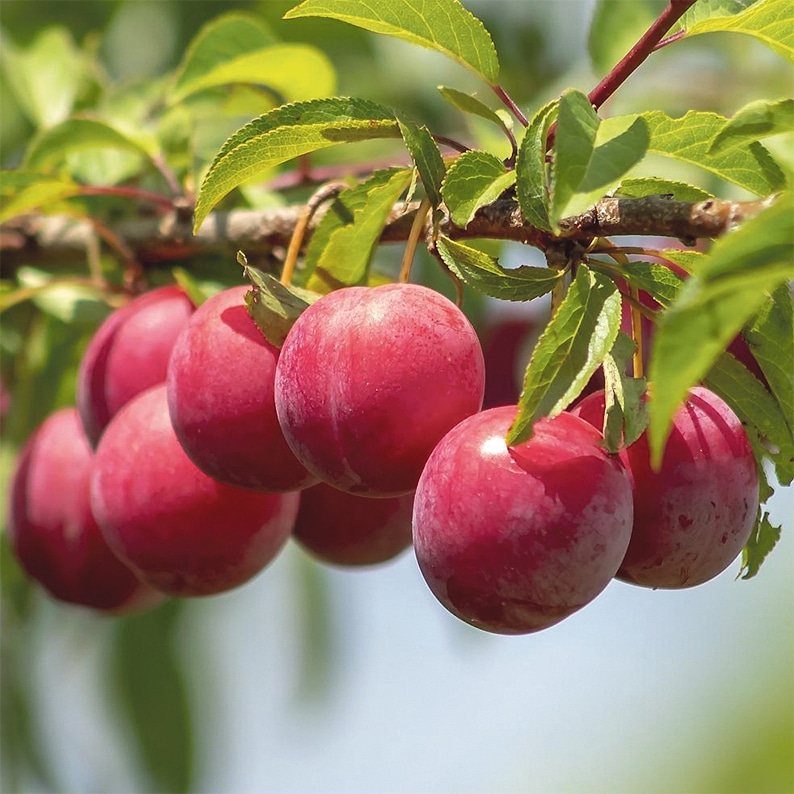If you have any extra space in your garden and are considering what to grow, consider a fruit tree? If you plant five or more, you now have an orchard! We have a great selection of bare root fruit trees at the moment here at Deelish Garden Centre, offering great value for money and choice of available varieties.
When considering where to plant your fruit trees, consider the following points; The single biggest enemy of fruit production is frost. Fruit trees flower relatively early and a late frost can wipe out your crop. Cold air is heavy and slides downhill so keep your orchard out of dips, valleys, hollows and sheltered flat ground. Because it is heavy, it displaces warmer air so the warmest spots at night tend to be 100-300 feet above sea level on a slope away from the prevailing wind. Paradoxically, that warm, sunny southwest facing slope will get the prevailing wind (and gales) if it is not sheltered. Pollinating insects hate the wind. A sheltered north-east facing slope is better than a wind blasted south-western one. Remember, if you are planting in a high spot, that wind shelter is essential, and you may need to plant a windbreak to protect your trees and ensure pollination. Here in West Cork, I have seen fruit trees successfully grow in a range of positions from close to the coast (in a sheltered spot) right up to peaty mountainside fields. So if you do not have a warm sunny slope, don’t worry too much!
The soil does not need to be especially rich (although good soil helps). The number one soil requirement is that there is a combination of adequate drainage and sufficient moisture. The worst soil is heavy clay which, although rich, is under water all winter and brick hard all summer. Fruit tree roots need to breathe and, at the same time, they need access to water to help swell their fruit. Good soil texture helps moisture retention and prevents fruit splitting, which is a classic sign of an uneven water supply.
Once you have decided where to plant, it is time to decide which type of fruit tree to plant. My first advice is to grow what you enjoy eating, as there is no point in planting an orchard of apples if no one in your family likes eating them!
Apples are the most popular choice of fruit tree and also the most reliable croppers. The majority of apple varieties are either eating or cooking, although some are dual-purpose (used for eating or cooking), such as ‘Granny Smith’ or ‘James Grieve’. Early season apples tend to be best eaten fresh from the tree, popular varieties include ‘Discovery’ and ‘Beauty of Bath’. Mid season apples can be picked fresh from the tree and kept for up to a month in storage. Varieties such as ‘Katy’ and ‘Cox’s Orange Pippin’ are both very tasty apples. Late season apples won’t be ready until they have been stored for four to five weeks and can last for several months, lending themselves to dessert use from late winter, this group of apples are known as late fruiting and include a large number of options such as ‘Bramley’s Seedling’ (a brilliant cooking apple), ‘Braeburn’ and ‘Gloster’. We also stock a great range of heritage apples, grown here in Co. Cork. This group of apples includes eating, cooking dual purpose and even cider apples that have been selected from varieties grown in old gardens and orchards that were in danger of being lost forever and have been successfully saved for future generations to enjoy. If space is limited in your garden, or you are looking for an unusual feature in your garden, we have duo (two varieties on one tree) and trio (three varieties on one tree) in apples and other fruit trees as an option to be planted in the ground or large pots. Most apples require at least one or two other suitable varieties or crab apple (which make have high levels of pectin for setting jams and jellies) to pollinate the flowers, which go on to produce fruit. We are happy to help you make the right choice for successful pollination on a visit to our Garden Centre.
Plum trees grow very well in West Cork and you will get a good harvest most years. There are many different types of plum, including sweet (‘Victoria’ and ‘Opal’ are lovely options) cooking varieties, damsons, gages, mirabelles and sloes. They have a variety of different uses, from eating freshly picked to making cakes and preserves and adding to gin.

Most are self fertile, meaning they can set fruit with only one variety, but I would recommend at least two to start with. As with all fruit trees that have a stone in the centre of the fruit, these trees are pruned in late spring or summer when the tree is in leaf.
Cherries make a wonderful tree for all sizes of garden. Many varieties are attractive trees, bearing spring blossom, colourful fruit, interesting bark and foliage that turns orange, red and yellow in autumn. Both sweet and sour (Morello) cherries are available to grow, each type of tree needing slightly different requirements. All can be grown in containers (we have these on dwarf rootstock), as freestanding trees or fan-trained against a wall. They do require careful maintenance, but enjoying freshly picked cherries makes growing them worth the effort. Grown as a tree, they can reach heights of five to seven metres high, so pick a spot in your garden with plenty of space, or choose a variety grown on dwarf rootstock, which will grow up to two metres high.
Pears are very ornamental trees, bearing attractive spring blossom and gorgeous autumn colour, and the addition of delicious home-grown pears is a bonus. Grown onto rootstocks of varying sizes, pear trees can easily be grown in smaller spaces and containers. There’s also a wonderful range of pear cultivars to grow, offering far more choice and flavour than you can find in a supermarket. Most gardeners find to get a good harvest, we need a hot summer and as we all know, living in West Cork this is not always the case! However when you do get a good harvest, biting into a juicy Pear you have grown yourself is hard to beat!
We also stock Asian pear trees. The fruit is like a cross between an apple and a pear, its white flesh crisper and crunchier with a hint of strawberry-like flavour. The trees are vigorous and have attractive foliage, good autumn colour, as well as dark bark (similar to walnut) that make them an excellent ornamental tree in their own right. These trees need another variety for fruit pollination and we stock ‘Hosui’ and ‘Niitaka’ at the moment.
If you have space in your polytunnel conservatory or glasshouse for a fruit tree, there are some of the most rewarding options available; these include self-fertile varieties of Peach, Nectarine and Almonds. As these trees flower early in the season when not many pollinating insects are active, they may need some help to produce a large crop of fruit. This is a fun job that involves using a paint brush or similar tool to gently brush each flower, which in turn greatly increases the number of fruits that successfully set on the tree. I have talked to some gardeners that have grown this group of fruit trees outside in a sheltered spot or south facing wall with some success in producing a good crop of fruit.
Other more unusual fruit trees we stock include fig trees, which work very well in a sunny well-drained position such as a warm wall or rock face. For maximum fruit, many gardeners recommend restricting the area for roots to grow, by planting in a sunken pot or placing blocks around the base of the tree. The most popular variety is ‘Brown turkey’ but we also stock other varieties that fruit well. Mulberry trees are easy to grow, as long as you have the space. They tend to have a wide habit so need enough room to spread out. They also need to be somewhere warm, so are perhaps best for gardeners in the milder parts of the county. Mulberry fruit is unusual to see for sale in shops, as it is best eaten fresh from the tree during their short, but glorious season, but definitely don’t wear any white clothes while picking the fruit, as their ability to stain clothes is unsurpassed. Another very popular fruit tree which we planted on the Deelish roundabout in Skibbereen is the Olive tree. I have been surprised to see plenty of fruits form during a good summer. I have to say the taste straight from the tree was not good and have learned that you need to cover the fruit in brine, leave to ferment for a few weeks and then add seasoning and seal the container for a few more months. If all that seems like too much trouble you could press the fruit to make your own olive oil! Medlars are quite easy to grow and don’t have any soil preferences. They usually start to crop after two to three years and won’t get too big – three to four metres is usual, when fully mature. The fruits of a Medlar aren’t to be eaten straight from the tree. In fact they really only suit jelly making. Quinces are easy to grow and, whilst they can be pruned and trained like a pear tree (to which they are related), they don’t have to be pruned at all. The fruit is used for making Quince jelly, which is a famed accompaniment to cold meats. They are also added to stewed apples or pears, or apple pie. Quince can tolerate wetter soils than many other fruit trees, and can be grown near the bottom of a slope.
So, as you can see there are many options to choose from when picking what fruit tree to grow in your own garden. Call in to us at Deelish Garden Centre and we will be happy to show you what is still available this season. Remember, gardening doesn’t have to cost the earth.



